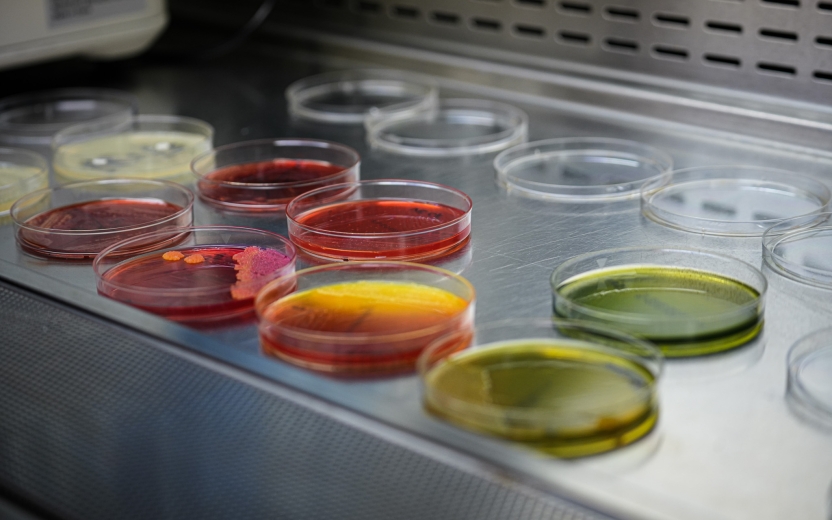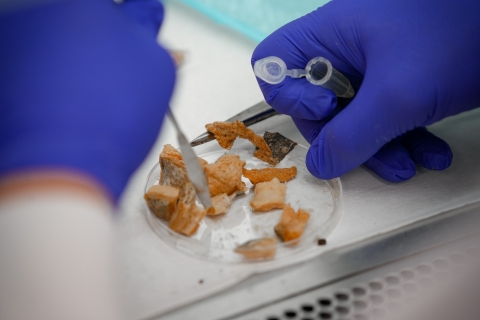Raw foods for dogs: Evidence-based advice from the Riney Canine Health Center
Looking towards the best health for their companions, many owners, and even some veterinary professionals, have embraced feeding raw meat diets. In their 2022 Annual Report, our Cornell Feline Health Center took a definitive stance against this practice. They describe how the health risks to both cats and owners far outweigh the benefits. But how about for dogs? What foods should you look out for, and what risk factors should be considered?
First of all, we think the most important information for our readers to know is that not all raw diets look like raw meat. Sure, if you order a ground up, frozen rabbit from a specialty website, then you know what you’re getting in to. But all pet owners should be aware that raw meat can also be sold on grocery store shelves as dried or freeze-dried treats and freeze-dried coated kibble. When it comes to the risks from bacteria and parasites, freeze-drying is not equivalent to cooking. In fact, it’s the opposite. At our research facilities, when our scientists need to preserve bacteria to study them, one of the ways we accomplish this is to simply dry them out. They can survive in a dried state for decades.
Dried pig ear treats, as a classic example, are typically not cooked. A recent outbreak investigation report published in The Lancet Regional Health describes how contaminated pig ear treats made their way into the US and Canada and sickened at least 154 people with salmonellosis over a four-year period. Fortunately, no deaths were reported. Two concerning aspects of this outbreak, however, are: 1) the majority of strains were multidrug resistant; and 2) more than half of the people hospitalized were outside of the age ranges considered high-risk.
Why should we care about resistant bacteria if everyone survived? Bacteria, in particular Gram negatives like Salmonella and E. coli, can share genes with each other. Some genes responsible for antimicrobial resistance are particularly mobile. After the Salmonella are cleared, the dogs and humans (and likely other animals) exposed to these strains now may be harboring additional genes encoding antimicrobial resistance as part of their gut microbiome. If they need those critical medicines in the future, it’s possible that they might not be effective. Think of your microbiome like a toolbox: just like it can have beneficial aspects that help you fight disease, new infections can also mine your microbiome for resources to survive.
Back to the more immediate risks, we know based on a research study conducted by the FDA Center for Veterinary Medicine, that your odds of being exposed to a foodborne pathogen (Salmonella, Listeria, or toxigenic E. coli) in frozen raw meat diets for pets purchased online are about 1-out-of-3. This study was conducted over a decade ago (published in 2014), when the jerky-style dried treats were more popular. Now, freeze-dried meat for pets is widely available on grocery shelves in various forms including treats, toppers and coated kibble. These are typically right next to the cooked products on the shelves, with no warning label that the contents are uncooked. A more recent study from researchers at the University of Pennsylvania found that 10 percent of canine raw food products contained Gram negative bacteria that produced extended spectrum beta-lactamases (ESBLs), enzymes that degrade penicillins and cephalosporins, making treatment of those infections quite difficult. Infection with these bacteria were attributed to over 9,000 deaths of hospitalized patients in the US in 2017, according to the Centers for Disease Control and Prevention (CDC).
If you purchase a raw product, you should treat it like any other raw meat that you would buy for your family. This means handle it very carefully, containing any splashes or drips, and cook it to an internal temperature of 165 degrees prior to feeding it to your dog. Do not wash it in the sink first. Clean and disinfect all surfaces and dishes afterwards, and of course wash your hands thoroughly with soap. If you choose to give your dog freeze-dried treats (or any other raw food), do not let anyone in high-risk groups (young, old, immunocompromised, or pregnant) come in contact with the product or the dog. Even if your dog doesn’t look sick, they could be shedding organisms that would likely harm those family members. A large epidemiologic study published in 2017 indicated that raw meat consumption was a significant risk factor for Salmonella shedding in dogs, and close to half of the infected dogs appeared healthy.
What to do if your dog does get sick? Your first call should always be to your veterinarian. Look out for diarrhea, vomiting, or change in behavior. Be sure to tell them if there were any changes in diet, and especially let them know if a raw, dried, or freeze-dried product was given. If a commercial pet food product is suspected as the source, anyone can make a report to the U.S. Food & Drug Administration on their website or over the phone. They have a great team of veterinary medical officers and an extensive network of laboratories that can provide additional support.
The bottom line is that we want you to know the full risks and benefits of what you feed your dog. Be sure to read labels carefully and reach out to your veterinarian if you have any concerns.
This page was last updated on Tuesday, Dec 09, 2025



